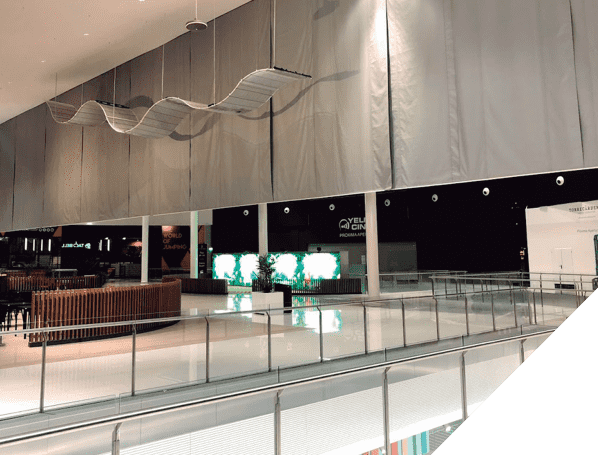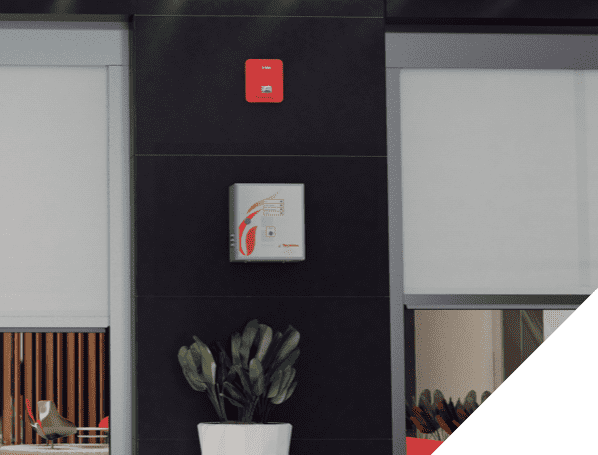Solutions
Fire Curtains
Fire curtains are mobile textile systems for compartmentalising and sectorising in case of fire. They are automated systems designed to guarantee integrity, isolation and low radiation in any case, as well as the non-penetration of smoke.
I'm interested
Smoke Control Curtains
Smoke control curtains are fixed or mobile textile screens designed to channel, contain and/or prevent the spread of gases generated in case of fire.
I'm interested
Control units
Control units are modular, autonomous elements intended for the control and management of Tecnitex mobile curtain systems. They may be connected to fire detection units, smoke and temperature detectors, or other SHEVS (Smoke and Heat Exhaust Ventilation Systems). Once the alarm or order has been received, the units will take charge of unfolding the barriers, controlling their position and status at all times; once this alarm or order is restored, the units will automatically reset.
I'm interested
Services
Applications
We have experience, with specialisation in the management of products in the fire safety engineering sector.
Get to know us





Discover our corporate catalogue
Discover our products and services, and all their technical specifications DownloadSuccess Stories
More information about Fire Compartmentation
What is Fire Compartmentation?
Fire compartmentation is a crucial aspect of building design and safety management. It
involves dividing a building into distinct sections or compartments to contain fire outbreaks,
prevent their spread, and protect occupants and property. Each compartment is constructed
using fire-resistant materials to inhibit the passage of flames, smoke, and toxic gases,
thereby limiting the impact of fire incidents.
Why is Fire Compartmentation Important?
Fire compartmentation plays a pivotal role in safeguarding lives, minimizing property
damage, and maintaining business continuity. By confining fires to specific areas, it enables
swift evacuation, reduces the risk of injuries, and facilitates the intervention of firefighting
teams. Moreover, effective compartmentation enhances the resilience of structures against
fire hazards, ensuring regulatory compliance and enhancing the overall safety of occupants
and assets.
What is the Main Objective of Fire Compartmentation?
The primary goal of fire compartmentation is to contain and control fires within specific areas
of a building, ensuring the safety of occupants, protecting property, and facilitating firefighting
efforts. By dividing structures using fire-resistant materials, compartmentation aims to limit
the spread of flames, smoke, and heat, preserving life, property, and structural integrity. It
also helps buildings comply with safety regulations and standards. Overall, fire
compartmentation plays a crucial role in mitigating fire risks and creating safer environments.
When is Compartmentation Needed?
Compartmentation is essential in various types of buildings, including residential,
commercial, industrial, and institutional facilities. It is particularly critical in high-rise
structures, healthcare facilities, educational institutions, and places with high occupancy
levels. Compartmentation is mandated by building codes and fire safety regulations to
mitigate the spread of fire and maintain structural integrity. It should be incorporated into
building designs from the initial planning stages and regularly inspected and maintained to
uphold its effectiveness.
What if My Building Does Not Have Adequate Fire Compartmentation?
Insufficient or compromised fire compartmentation poses serious risks to occupants,
property, and regulatory compliance. Without adequate compartmentation measures in
place, fires can rapidly escalate, endangering lives and causing extensive damage.
Inadequate compartmentation may also result in legal liabilities, fines, and reputational
damage for building owners and managers. Therefore, it is imperative to address any
deficiencies promptly through comprehensive assessments, retrofits, and maintenance
strategies to ensure optimal fire safety standards are met.